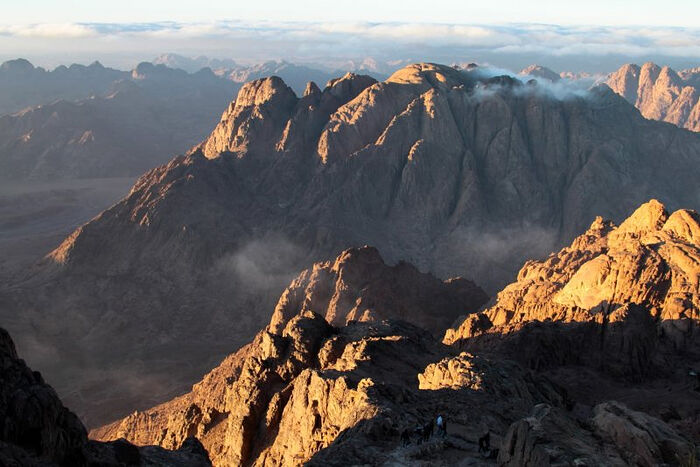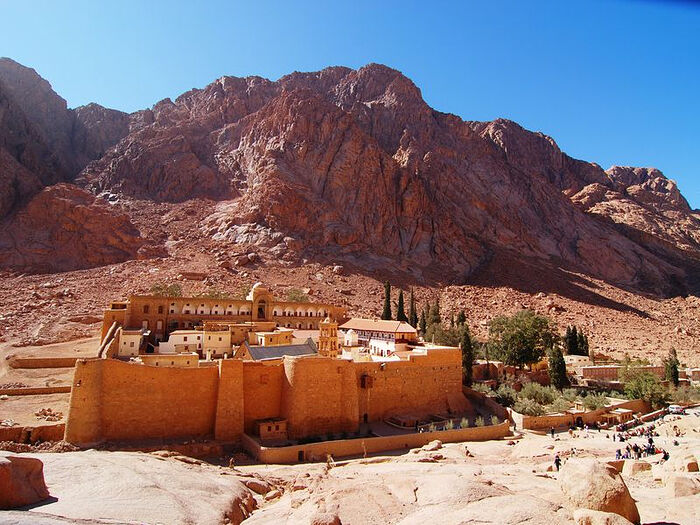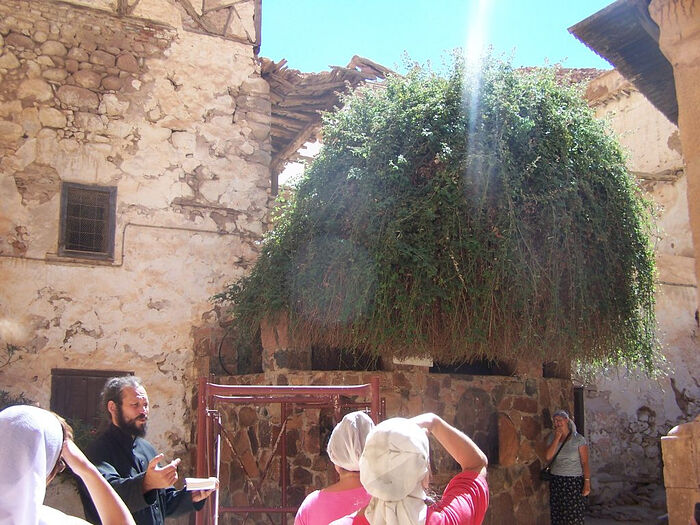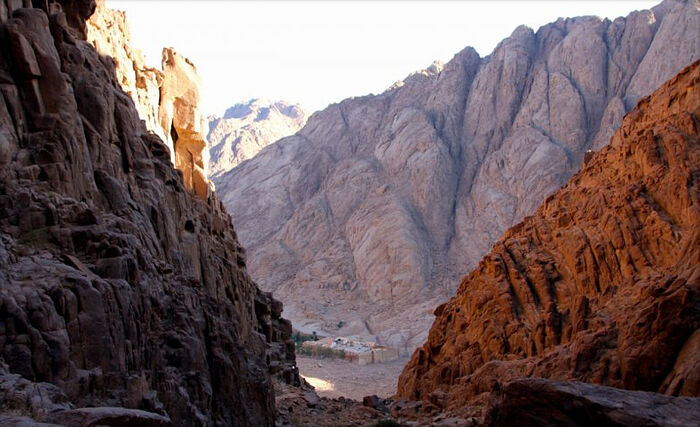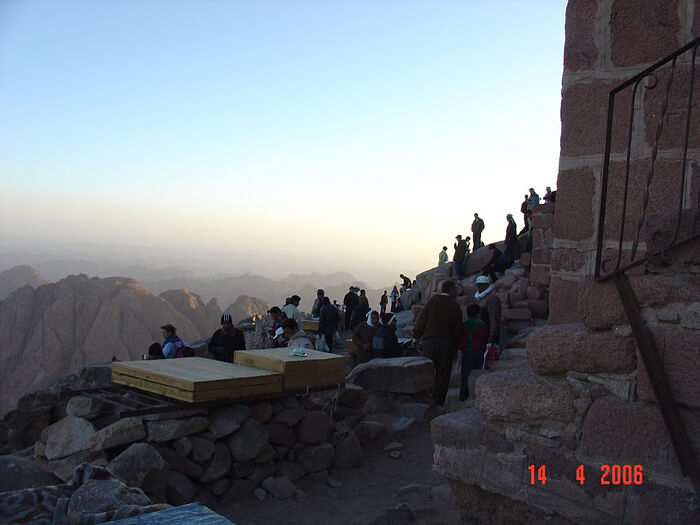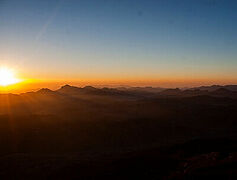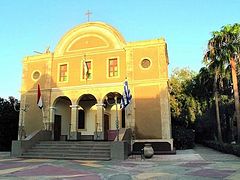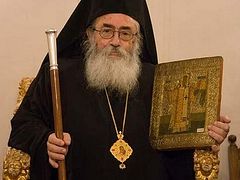And He said, Draw not nigh hither: put off thy shoes from off thy feet, for the place whereon thou standest is holy ground (Ex. 3:5)
There is a place on earth where God Himself appeared to man. And there, God called on man to meet with Him. It is Mt. Sinai, which is so remote in earthly terms and so close to every heart that has touched it. How many shrines the Lord and His Heavenly Church left on this sinful earth, but only this place can be characterized by one phrase that strikes the human mind: Mt. Sinai is the meeting place of God and man.
Mt. Sinai. Mysterious and silent in space and time... When you think about this tiny piece of land on the world map, you keep marveling. How many historic events and wars have taken place here, and how many peoples and religions have intertwined here! It attracts pilgrims from all over the world, of different nationalities, faiths and denominations: Jews, Catholics, Orthodox and even Muslims. The Old and the New Testaments are closely intertwined in this place. To put it simply, it possesses a special holiness. God Himself appeared here.
Once, as Moses was tending his sheep in this area he stumbled upon the Burning Bush: And the angel of the Lord appeared unto him in a flame of fire out of the midst of a bush: and he looked, and, behold, the bush burned with fire, and the bush was not consumed… God called unto him out of the midst of the bush, and said, Moses, Moses. And he said, Here am I. And he said, Draw not nigh hither: put off thy shoes from off thy feet, for the place whereon thou standest is holy ground… And the Lord said, I have surely seen the affliction of My people which are in Egypt… Come now therefore, and I will send thee unto Pharaoh, that thou mayest bring forth My people the children of Israel out of Egypt (Ex. 3:1, 4, 5, 7, 10).
This was the first meeting.
While wandering in the desert with the Jews, Moses stopped to take the tablets—the commandments of the Old Testament—and pass them on to people who had fled from the Egyptian captivity, and later to all mankind:
In the third month, when the children of Israel were gone forth out of the land of Egypt, the same day came they into the wilderness of Sinai... And there Israel camped before the mount... And it came to pass on the third day in the morning, that there were thunders and lightnings, and a thick cloud upon the mount, and the voice of the trumpet exceeding loud… And mount Sinai was altogether on a smoke, because the Lord descended upon it in fire... And the Lord called Moses up to the top of the mount; and Moses went up. And the Lord said unto Moses… (Ex. 19:1, 2, 16, 18, 20, 21).
This was the second meeting.
So says the Old Testament, and what followed was the foundation of the Christian faith, a part of the world order. According to the Old Testament, Moses received the Ten Commandments from God. Since then, Sinai has been considered one of the holiest places of Christendom.
Despite the sweltering heat in summer and freezing cold at night, it is a majestic place of virginal beauty, untouched for centuries. Only Bedouins have lived here for thousands of years. It is a stone island in the middle of the sea of the desert that has been preaching tolerance for centuries. With the advent of Christianity, a monastery appeared here on the site of the Burning Bush. This phenomenon is one of the mystical secrets of Sinai.
It is one of the earliest permanent Christian monasteries in the world. It was founded in the fourth century in the central part of the Sinai Peninsula near the Biblical Mt. Horeb (Sinai). Initially, it was called the Monastery of the Transfiguration, or, of the Burning Bush. And after the repose of the holy Great Martyr Catherine, whose relics were transferred by angels to the top of Mt. Sinai (they were discovered by Sinai monks in the mid-sixth century), the monastery received its second name—in honor of St. Catherine.
 Icon of Christ the Pantocrator. Sixth century The first thing that caught my eye when we entered the monastery was an icon of the Savior—Christ the Pantocrator. It is an encaustic icon of the mid-sixth century depicting the Savior, which is the oldest known icon. In addition, the monastery has a unique collection of ancient manuscripts and icons.
Icon of Christ the Pantocrator. Sixth century The first thing that caught my eye when we entered the monastery was an icon of the Savior—Christ the Pantocrator. It is an encaustic icon of the mid-sixth century depicting the Savior, which is the oldest known icon. In addition, the monastery has a unique collection of ancient manuscripts and icons.
Arab caliphs, Turkish sultans and even Napoleon’s army did not disturb the peace and tranquility of the monastery. It has never been destroyed or attacked, thus maintaining its autonomy and inviolability. Everyone sought to take the monastery under their protection. It seemed that the Lord Himself protected it.
On the territory of the monastery there is a mosque tower as a sign of respect for Mohammed and a symbol of reconciliation. Once the Muslim Prophet Mohammed stopped at the foot of the magnificent Mt. Sinai, in St. Catherine’s Monastery, leaving a charter to his followers for the freedom of worship and movement in this place. This is also evidenced by the library, which contains about 5,000 manuscripts of early printed editions, including one of the richest collections in the world, which, in comparison with the Vatican, is considered the most complete collection of all Christian literature. Previously, the earliest known manuscript of the Bible, the Codex Sinaiticus, was kept here.
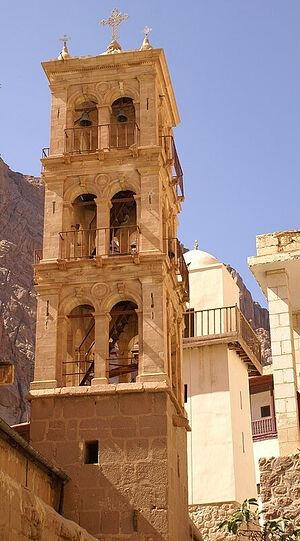 Belfry and tower of the mosque at St. Catherine’s Monastery The beauty of the ancient monastery was mesmerizing. Darkened wood, ancient paintings and mosaics. Even the monks seemed to have come from the past. We pilgrims prayed at a prayer service and were given rings blessed on St. Catherine’s graceful hand. And we went into the yard to admire the Burning Bush. We took pictures around it from different angles alternately with the whole group. But, most remarkably, when we looked at our developed photos after returning home, we saw a pillar of light from the top of the Bush upwards. Dazzling white against the blue sky, captured from different cameras, in different photos taken at intervals of several minutes. So, invisibly, it continues to be the Burning Bush!
Belfry and tower of the mosque at St. Catherine’s Monastery The beauty of the ancient monastery was mesmerizing. Darkened wood, ancient paintings and mosaics. Even the monks seemed to have come from the past. We pilgrims prayed at a prayer service and were given rings blessed on St. Catherine’s graceful hand. And we went into the yard to admire the Burning Bush. We took pictures around it from different angles alternately with the whole group. But, most remarkably, when we looked at our developed photos after returning home, we saw a pillar of light from the top of the Bush upwards. Dazzling white against the blue sky, captured from different cameras, in different photos taken at intervals of several minutes. So, invisibly, it continues to be the Burning Bush!
With our insensitive hearts, we weren’t able to see this pillar shining up to the sky while taking photos. But at home it became a revelation for us: the imprinted light of Divine Love for people. And on the second trip we were vouchsafed to enter the altar of the monastery, built next to the Burning Bush in ancient times; taking off our shoes, we were able to venerate this sacred place.
We started climbing Mt. Sinai. Having walked up the first half, we found ourselves on a wide platform between the mountains. Everything there was well arranged for relaxation: trailers for snacks and blankets for sleeping at the top. We took pictures and continued climbing. Some walked, while I almost crawled. My head was pounding, my eyes saw poorly, and my legs were moving automatically. “Here they are, my grave sins!” this thought flashed through my mind. While everyone was moving ahead, I slowed down, sat down on a stone and confessed to my friends that I couldn’t take another step. They sat down for company, and I don’t remember how I fell asleep. When I woke up, I saw that my friends were sleeping too. To be close to the top without climbing it—isn’t that a misfortune?
But we had to go back. Some Arabs showed us the way. A path leading to the monastery opened before us. It looked so small from above. The path was narrow and terribly dangerous. It rushed down sharply. St. John Climacus probably saw this path in front of him, describing his Ladder to Heaven, or rather, to eternity. Although he had ascent in mind, we were going down. The fear of falling off was so strong that sometimes I wanted to grab the air with my hands. We only just descended the mount and literally collapsed by the monastery from fatigue.
We have a nun friend. Her first ascent on Mt. Sinai was swift. Surrounded by sisters of Gorny Convent, and most importantly their prayers, she did not notice how she reached the summit. Subsequently, her second ascent was completely different. She began her journey self-confidently with only one thought: “It’s easy!”—and soon got tired. Halfway through, she lost consciousness! When she came to her senses, she saw a white-toothed black man with a smile from ear to ear. He asked her in broken Russian:
“Are you alright?”
“Yes, I am,” she answered quickly. Her legs could barely trudge to the peak. The following question arises: what was the difference? The inner state of the soul. The contrition of the sisters’ spirit in a prayerful and repentant feeling and in the self-confident words: “It’s easy!”. Previously, pilgrims would climb Mt. Sinai while reciting the Jesus Prayer. Monks would stand at sharp turns of the path and pilgrims would confess their sins to them. And the ascent went easier.
St. John Climacus wrote his famous work during his abbacy at St. Catherine’s Monastery, contemplating in front of him both figuratively and spiritually this long path of repentance, improvement in spiritual warfare and overcoming yourself. Everything indicated that there was only one way to your meeting with God: that of repentance and seeing your sins. The path of prayer and faith. Then the Heavenly Ladder will become surmountable.
The second attempt
Remembering my unsuccessful, or perhaps useful experience of such an ascent, on the second trip I behaved differently. Knowing me and my cowardly character, Fr. Igor told me to head our group, although there were those who already knew the whole way to the summit. Without hearing my words: “Oh, I can’t! I don’t know the way”, or seeing my face twisted with horror, the priest turned and walked away. A wide stone path lay in front of me in the moonlight. The moon hung like a huge pearl lampshade in the black sky. And we climbed. I had no choice: people were standing around, looking at me in expectation, including those who had already been climbing. The only thing left to do was to let them down in horror. and reading the Jesus Prayer unceasingly has always been the only driving force in my life. However, responsibility is a terrible power. It drove me non-stop almost to the very top, despite my legs that had gone numb. But in such minutes and hours prayer is special—with all your heart, or maybe out of fear. Turning left after the familiar rest area we found ourselves in utter impenetrable darkness. And, fearing not to reach the destination and illuminating the path with a flashlight, I continued at random, where our feet were leading us. And they brought us to the very church at the top of Mt. Sinai—where there was a meeting between God and man.
And here is the top! We were dead on our feet. After a couple of minutes, we were carefully covered with blankets, tucking in the edges, and I fell asleep.
Soon the first colors of the morning sun illuminated the horizon. Dawn began to gleam. Dawn, which each of us has seen hundreds of times. But that one was special. We met it in Sinai. It was Friday, a day of strict fasting and the commemoration of the Lord’s ascent to Golgotha. And the day began according to the Church calendar in honor of St. Mary of Egypt.
They say that all sins will be forgiven to him who meets the sunrise on Mt. Sinai. While understanding the absurdity of this legend, we will remember the beauty of this phenomenon to the end of our lives. The beauty of the beginning of a new day in a special place, and as the beginning of a new life—dawn over the meeting place of God and man. An amazing view opened before us. We were at the highest point of the mountain range, with the mountains spreading before us with their peaks. And if there were many periods of destruction and restoration in the holy land in connection with wars, then here there was completely intact beauty preserved without human intervention, surrounded by pristine nature. And, surprisingly, there is no singing of birds, no bushes, no grass. Scorching sun by day and piercing wind by night. And silence, utter silence, as if reminding us that it will be the mystery of the age to come.
Only cliffs and huge boulders scattered at the foot of Mt. Sinai resembled the description in the Old Testament of the formidable presence of God in a thunderstorm, lightning, clouds, flames and trembling of the earth in this very place where the Jewish people languished in anticipation. But, no matter how majestic was Mt. Sinai, even more exalted were the words of God Himself, which through thunder, lightning and smoke reached the ears of people. It was the famous Decalogue: The Ten Commandments of God, in each of which eternal truth was revealed.
What did the centuries-old history of the Indians, the Egyptians and other peoples, with all their wisdom and huge temples and pyramids, mean in comparison with the Law given to Moses at Sinai for all future ages? It laid the foundation for true morality and human dignity in the world. It was the birthday of a nation different from all others. Simple, but deep and eternal truths about the spiritual, about God, about honoring your parents, about chastity, about the sanctity of human life, about purity and conscience—all these truths were approved at Sinai. The Decalogue was proclaimed by God Himself with such irresistible majesty and amazing simplicity that the truths proclaimed in it immediately became the property of the whole people, whose task was to extend this law to all mankind. The Law given by God at Sinai not only establishes the true views on the Godhead and the attitude of humanity towards Him, but also puts mutual relations between people on a completely new level. In honor of this great event, the Israelites established the feast of Pentecost, since this event took place on the fiftieth day after the Jews had left Egypt.
It is here that we recall the following verses from the Old Testament: Thus saith the Lord, The heaven is My throne, and the earth is My footstool: where is the house that ye build unto Me? and where is the place of My rest? (Is. 66:1).
Here was His temple not made by hands, and here in front of Him stood a weak man, like a grain of sand before the universe. It was Moses. Although he was hardly able to speak to people, he was a great prophet, endowed with Divine power in the leadership of the Jewish people and in the glory of His miracles. Moses, whose obedience to God in this changing world made him great before all mankind and its history.
What can a person feel after overcoming himself? Joy. And I didn’t remember my ascent on my legs that went numb, the fear of letting people down, the difficulty of the road and the nighttime cold. I wanted to run skipping, as in childhood, forgetting about aching muscles, along these sunlit stones—which in fact I did, with great pleasure.
Divine Light is a scorching fire for sinners, but for those who seek Him they are purifying. Purifying our hearts through repentance, He pours out the light of His Divine Love on us, granting us stillness and peace. Thus, the Kingdom of Heaven is created invisibly within us.

